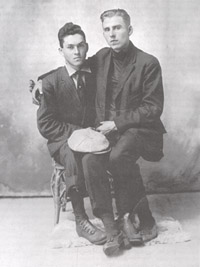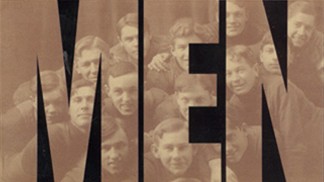Seeing Males Together: Brokeback Mountain and Picturing Men
An essay by John Ibson, author of Picturing Men.
History’s fundamental lesson warns those who are comfortable with contemporary social arrangements, as it reassures those who are oppressed by current practices: It hasn’t always been like this, and isn’t likely to stay this way forever. This lesson is certainly true when it comes to the way that American men today are inclined and allowed to express their affection for each other—whether that affection involves romance, sexual longing, or just profound fondness.
Ang Lee’s magnificent film Brokeback Mountain is the sad story of two Wyoming ranch hands whose society severely inhibits their twenty-year-long affectionate and sexual relationship. They express their mutual attraction only when utterly alone in the wilderness, at huge expense to their emotional lives and also their relationships with women. Yet Brokeback Mountain may also be instructively seen as a movie that raises disturbing issues about the ways that all American men feel about the appropriate ways to express their fondness for each other, whether or not that fondness is accompanied by sexual desire. Our culture still so scorns sexual desire between two men that there is a common fear that such desire just might accompany any fondness, as well as a fear that other people might jump to conclusions about the implications of two men’s attraction to each other.
Homophobia afflicts all males in our society, both those who genuinely are sexually attracted to each other, like Ennis del Mar and Jack Twist in Brokeback Mountain, as well as those whose love or simple affection for each other has no sexual dimension to it. For one man to tell another he loves him, some joking around often trivializes the expression, with all the depth of a commercial for Bud Light; if two men embrace, a reassuring punch is often part of the action. Simply because they are men, gay men—in spite of being sexually drawn to each other—may often be no less free of inhibition in expressing affection than are their straight brothers.
As a historian who has studied the shifting history of American men’s various sorts of relationships with each other, I think it is critical to note that Brokeback Mountain‘s Ennis and Jack were nineteen in 1963, the year they met. (So was I coincidentally.) They were shaped by the culture of 1950s America, a culture that was unusually hostile to male intimacy, as I argue in Picturing Men.
When most American boys learned to fear and despise any suggestion of queerness in themselves, Ennis received a peculiarly graphic lesson: His father made it a point to show his nine-year-old son the sexually mutilated corpse of a rancher whose relationship with the man with whom he shared a home had bothered his neighbors. Jack’s dream for himself and Ennis—simply to live together in peace—was a modest one, in contrast to the reasonable dreams of men today who want to marry each other. Yet, living when they did, Ennis could only warn Jack that if their feelings for each other were ever to “grab on to us again in the wrong place, wrong time, we’ll be dead.” Their intimacy had to remain in the shadows, making Brokeback Mountain a tragic tale of unrealized potential.
Picturing Men shows a different world. The lost world of American men that I depict in my work was a time when men clearly were comfortable with each other, feeling free to physically express mutual affection for all to witness—not hidden away on a Brokeback Mountain, but in front of a camera, wholly without the coldness or the reassuringly exaggerated gestures that would come to mark photographs from a later time. Picturing Men does not argue that the lost world was in every way better than the world of men today, but does surely maintain that the earlier world was different, and that our understanding it, and the reasons for its demise, might improve men’s relationships nowadays, with each other and with the women in their lives.
Picturing Men is based on my systematic scrutiny of thousands of everyday photographs of two or more American men together, from the dawn of photography before the Civil War until the early 1950s—both studio portraits as well as the snapshots that became common after the invention of roll film in 1888. The book displays well over a hundred representative images, showing men indoors and out, in homes, dorm rooms, and bunk houses, at the beach and in the work place, soldiers, sailors, and civilians, camping, hunting, and posing for athletic team portraits. The ways men posed with each other changed markedly over the time my book surveys, and my interpretation of those changes leads me to an interpretation of drastic changes in the quality of men’s various relationships with each other over a century of American history.
 As cultural evidence, photographs document certain things, yet are wholly silent about others. In looking at this photograph taken around 1915, we see two men doing something we rarely observe nowadays. I refer not simply to their pose, but to the fact that they had their portrait taken together in a photographer’s studio, a ritual once widespread among American men but extremely rare today. Many observers may confidently think they see evidence of romance and a likely sexual relationship in this photograph, but that judgment reveals something only about the observer, not the subjects. Without an inscription, we can actually discern nothing from this image regarding a matter that has come to obsess us about relationships: whether the parties are having sex with each other.
As cultural evidence, photographs document certain things, yet are wholly silent about others. In looking at this photograph taken around 1915, we see two men doing something we rarely observe nowadays. I refer not simply to their pose, but to the fact that they had their portrait taken together in a photographer’s studio, a ritual once widespread among American men but extremely rare today. Many observers may confidently think they see evidence of romance and a likely sexual relationship in this photograph, but that judgment reveals something only about the observer, not the subjects. Without an inscription, we can actually discern nothing from this image regarding a matter that has come to obsess us about relationships: whether the parties are having sex with each other.
What we do observe in this photograph—and in countless others—is male intimacy, two men who were clearly so comfortable with each other that they felt no need to clown around, to reassure themselves and anyone who would see their photograph that nothing culturally scorned was being displayed. Another of history’s critical lessons is that change always brings both gain and loss. Picturing Men maintains that certain losses that American men have experienced in their relationships with each other have been severe. It is not simply fictional ranch hands, and not just men sexually drawn to each other, whose lives today are full of unrealized potential.
